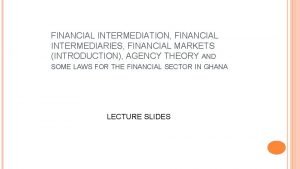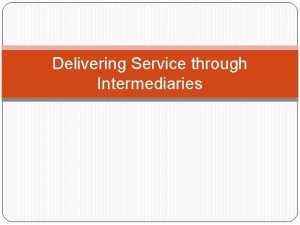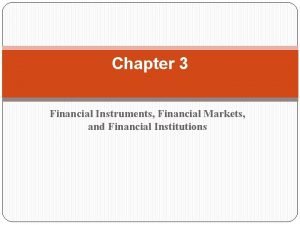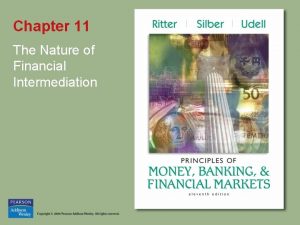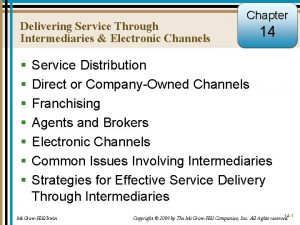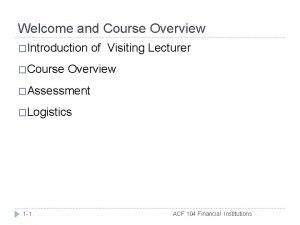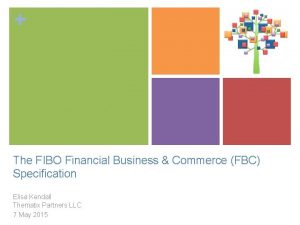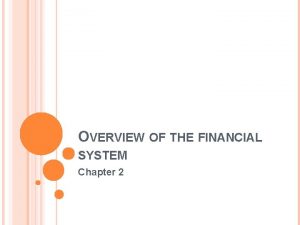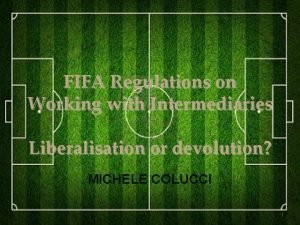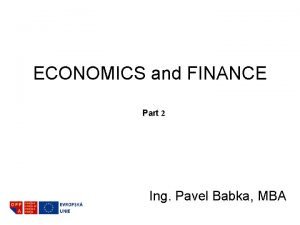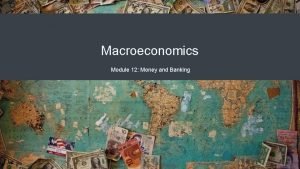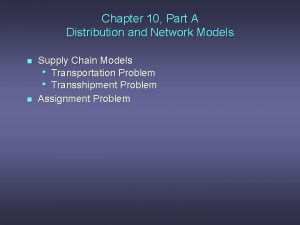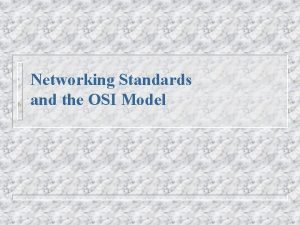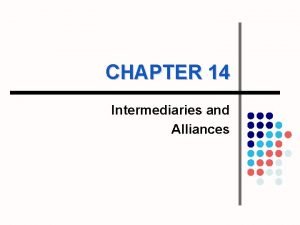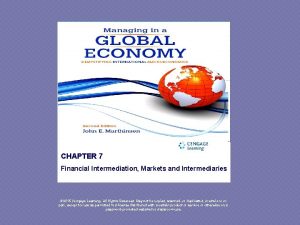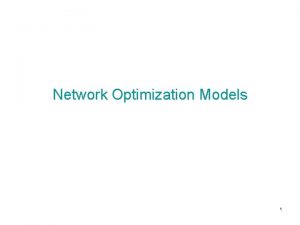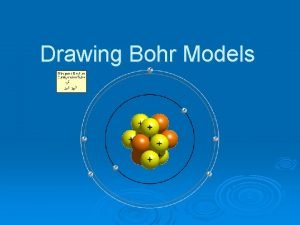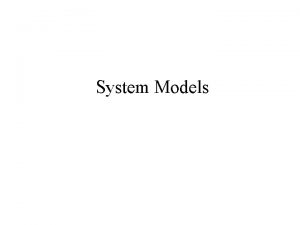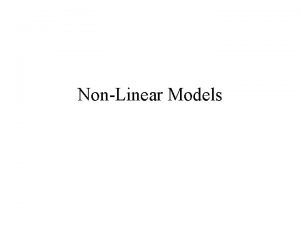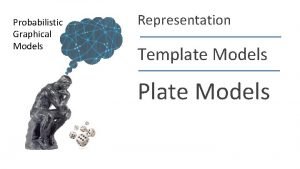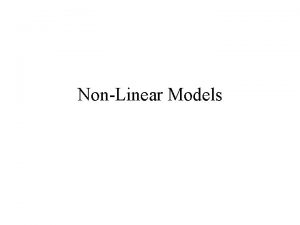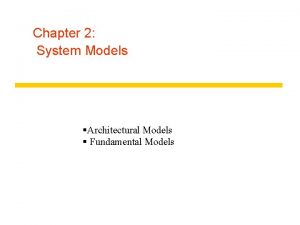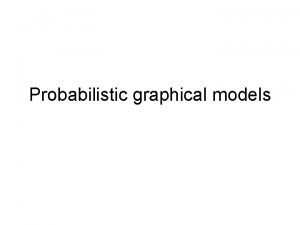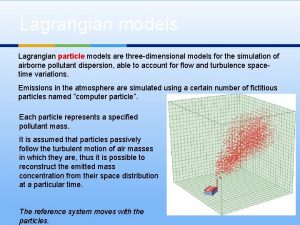Network Models of Markets with Intermediaries Agenda 11































- Slides: 31

Network Models of Markets with Intermediaries

Agenda • • 11. 1 Price-Setting in Markets 11. 2 A Model of Trade on Networks 11. 3 Equilibria in Trading Networks 11. 4 Further Equilibrium Phenomena: Auctions and Ripple Effects • 11. 5 Social Welfare in Trading Networks • 11. 6 Trader Profits • 11. 7 Reflections on Trade with Intermediaries

11. Pricing Setting in Markets • We know market-clearing price exists • The market-clearing price have the power to direct the allocation of goods in a desirable way • Who sets the prices in real market? • Why do they choose the particular prices ? • Who trades with whom if there are many buyers and sellers?

Trade with Intermediaries • Individual buyers and sellers do not interact directly with each other, but instead trade through intermediaries – Agricultural goods – Stock market • NYSE, NASDAQ-OMX, … • Direct Edge, Goldman Sachs, or Investment Technologies Group (ITG) • “order book”

Trade in the Stock Market • The highest outstanding offer to buy the stock is referred to as the current bid for the stock, while the lowest outstanding offer to sell it is referred to as the ask.

11. 2 A Model of Trade on Networks • Three fundamental principles – Individual buyers and sellers often trade through intermediaries – not all buyers and sellers have access to the same intermediaries – not all buyers and sellers trade at the same price • The prices that each buyer and seller commands are determined in part by the range of alternatives that their respective network positions provide.

A Trading Network • Market for agricultural goods between local producers and consumers in a developing country S : seller B : buyer T : trader Edge : any two agents who can trade with each other.

Network Structure • For the simplest form of the model – assume there is a single type of good that comes in indivisible units

Prices and the Flow of Goods • The flow of goods from sellers to buyers is determined by a game in which traders first set prices, and then sellers and buyers react to these prices. bti atj indi�erent (for S 3 and B 3) between accepting or rejecting the trade

Payoff • Trader : all his transactions –Σt atj - bti • Seller i : – selecting trader t is bti – selecting no trader is vi • Buyer j : – selecting trader t is vj − atj – selecting no trader is 0 – the buyer receives the good but gives up atj units of money

Best Responses and Equilibrium T 1 can undercut T 2 and move S 2 ‘s good to B 2

Best Responses and Equilibrium • Nash equilibrium – based on a set of strategies such that each player is choosing a best response to what all the other players are doing. • Backward Induction – First : the buyers and sellers in the second stage, after traders have already posted prices. – Next: the traders decide what prices to post in the first stage. • Subgame perfect Nash equilibrium

11. 3 Equilibria in Trading Networks • Monopoly – there is only one trader available to both the seller and the buyer.

Perfect Competition

Perfect Competition • Trader (T 1) is performing the trade at equilibrium must have a payoff of 0 – T 1 offering the same value x as his bid and ask. • Trader (T 2) not performing the trade at equilibrium must also have bid and ask values of x. – in equilibrium, we cannot have a trader buy the good from the seller without also selling it to the buyer -> T 2 must be offering a bid b ≤ x, and an ask a ≥ x. • The equilibrium occurs at a common bid and ask of x (0 < x < 1 ) • X is determined by the relative power of buyer and seller (outside options)

The Network from Section 11. 2 • The equilibria in the example from Section 11. 2

11. 3 Equilibria in Trading Networks • Perfect Competition – out of equilibrium – If T 1 is performing the trade and making a positive profit, his bid is number b, and his ask is a number a > b. – If T 2 is not performing the trade, T 2 payoff of zero – if T 2’s bid is b’ > b, and T 2’s ask is a’ < a , T 2 making a positive profit.

Implicit Perfect Competition • When a trader makes no profit from a transaction, it is always because there is another trader who can precisely replicate the transaction.

11. 4 Further Equilibrium Phenomena Auctions and Ripple Effects • Second-price auctions – a single individual S 1 with an item to sell, and four potential buyers who value the item at values w, x, y, z, listed in descending order w > x > y > z. – each buyer is represented by a distinct trader

Second-price auctions • In equilibrium – T 1 will outbid them by the minimum he needs (by offering x to outbid T 2). – use indifference to assume that the sale at x will go to T 1 rather than T 2, that buyer B 1 will buy from T 1 at a price of w

Ripple Effects from Changes to a Network • Small changes to the network structure can affect the payoffs of nodes that are not directly involved in the change

Ripple Effects from Changes to a Network • Equilibrium before new link

Ripple Effects from Changes to a Network • Equilibrium after new link – work out the equilibrium bids and asks charged to S 2 and B 2, and the flow of goods. – The two bids and asks to S 2 must be the same as each other (bid = z and ask = y) – S 2 will sell to T 2 rather than T 1 in equilibrium (B 3’s value is higher than B 2’)

Ripple Effects from Changes to a Network • Possible values (trader-buyer) – ask y must be at least 1 and not be above 2 • Possible values (trader-seller) – bid z must be at least 1 and not be above 3

11. 5 Social Welfare in Trading Networks • social welfare : the sum of the payoffs of all players • In the context of our game, each good that moves from a seller i to a buyer j contributes vj − vi to the social welfare. • In every trading network, there is always at least one equilibrium, and every equilibrium produces a flow of goods that achieves the social optimum

Equilibria and Social Welfare • Example Total = 7 Total = 9

11. 6 Trader Profits • As the network becomes more richly connected, individual traders have less and less power, and their payoffs go down • In order to make a profit , a trader must in some way be “essential” to the functioning of the trading network. • a trader makes a profit can depend on the equilibrium.

Trader Profits

Trader Profits • Traders T 1 and T 2 both have monopoly power over their respective sellers, and yet their profits are zero in every equilibrium. – Equilibrium look like (b) or (c) – all bids and asks equal 0 in any equilibrium

Trader Profits • If for a given trader T in a network, there exists an equilibrium in which T receives a positive payoff. – There exists such an equilibrium precisely when T has an edge e to a seller or buyer such that deleting e would change the value of the social optimum. – In such a situation, we say that e is an essential edge from T to the other node.

11. 7 Reflections on Trade with Intermediaries • Buyers and sellers in intermediated markets, such as the stock market, face a bid-ask spread – The size of this spread and how much the intermediaries make depends on the amount of competition between intermediaries • Interesting aspects not captured in the model – In particular, we do not ask where buyers’ and sellers’ values come from; nor do we ask about how they might use information revealed by bids, asks, or trades to update these values. (CH 22)
 Financial intermediaries and markets
Financial intermediaries and markets Agenda sistemica y agenda institucional
Agenda sistemica y agenda institucional What is the difference between models and semi modal
What is the difference between models and semi modal Marketing channel definition
Marketing channel definition Hurgusburgus
Hurgusburgus Types of financial intermediaries
Types of financial intermediaries Types of financial intermediaries
Types of financial intermediaries Types of electronic channels
Types of electronic channels Zurich intermediaries protection
Zurich intermediaries protection Financial intermediaries
Financial intermediaries Financial intermediaries
Financial intermediaries Bluestone for intermediaries
Bluestone for intermediaries Financial intermediaries
Financial intermediaries Money market participants
Money market participants Financial intermediaries
Financial intermediaries Fifa regulations on working with intermediaries
Fifa regulations on working with intermediaries Financial intermediaries
Financial intermediaries Chapter 2 an overview of the financial system
Chapter 2 an overview of the financial system Financial intermediaries ppt
Financial intermediaries ppt Fiat system
Fiat system Offshore employment intermediaries
Offshore employment intermediaries Distribution and network models
Distribution and network models Osi a model for computer communications standards
Osi a model for computer communications standards Layer task
Layer task Virtual and datagram networks
Virtual and datagram networks Network topologies
Network topologies Features of peer to peer network and client server network
Features of peer to peer network and client server network Network systems design using network processors
Network systems design using network processors Network centric computing and network centric content
Network centric computing and network centric content Packet
Packet Why study financial markets and institutions
Why study financial markets and institutions Two businesses operate in contrasting international markets
Two businesses operate in contrasting international markets
